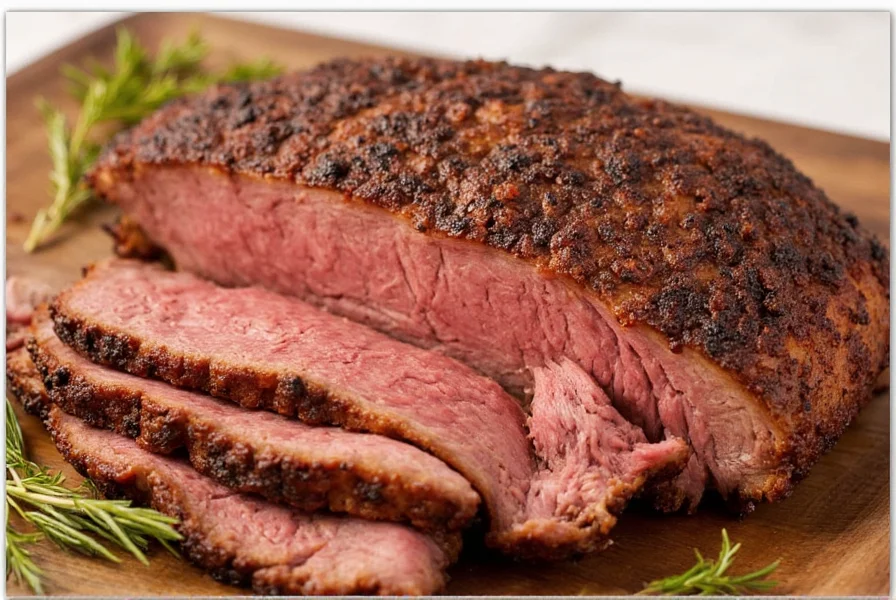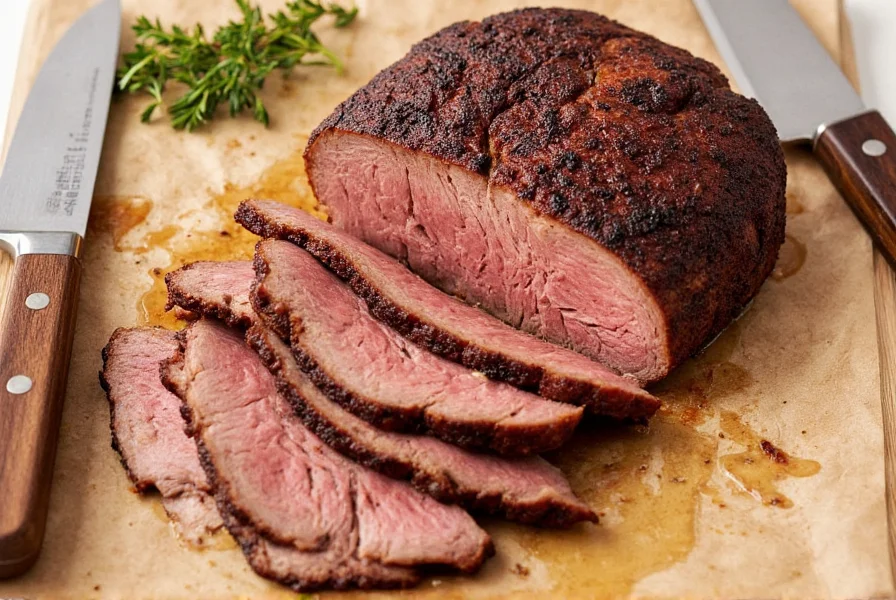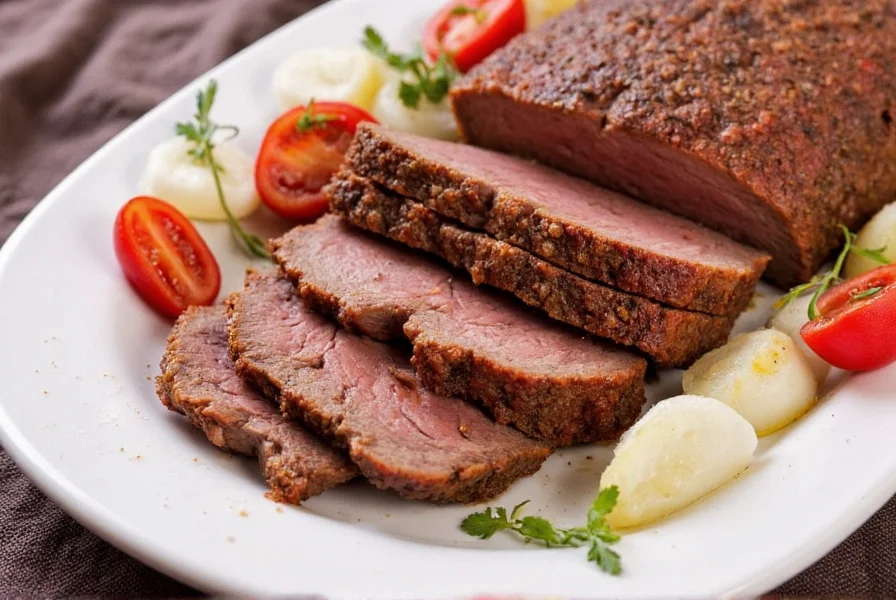The most reliable method for baking beef brisket involves seasoning a 12-14 pound brisket point cut with a dry rub, slow-roasting at 275°F (135°C) for approximately 1 hour per pound until it reaches an internal temperature of 195-205°F (90-96°C), then resting for at least 1 hour before slicing against the grain. This low-and-slow approach transforms tough connective tissue into tender, flavorful meat through collagen breakdown.
Beef brisket, a flavorful but challenging cut from the chest area of the cow, requires proper technique to achieve that perfect balance of tender texture and rich beef flavor. Unlike grilling or smoking, baking brisket in the oven offers precise temperature control that's ideal for beginners while still delivering exceptional results. This comprehensive guide shares professional techniques refined over decades of cooking this beloved cut, focusing on the science behind successful brisket preparation rather than just listing steps.
The Science Behind Perfect Baked Brisket
Understanding why certain techniques work transforms you from a recipe follower to a confident cook. Brisket contains abundant collagen, which begins converting to gelatin at 160°F (71°C) but requires sustained heat up to 205°F (96°C) for complete transformation. This scientific principle explains why low-and-slow cooking produces tender results while high-heat methods yield tough meat. The fat cap serves as both flavor enhancer and protective layer, slowly rendering during cooking to baste the meat naturally.
Essential Equipment and Ingredients
Before starting your oven-baked beef brisket recipe, gather these critical items:
- Meat thermometer - Non-negotiable for monitoring internal temperature
- Rimmed baking sheet with wire rack for proper air circulation
- Butcher paper or aluminum foil for the "Texas crutch" technique
- Sharp chef's knife for precise trimming and slicing
For the dry rub that creates the perfect bark on baked beef brisket:
- 1½ cups coarse kosher salt
- 1 cup coarse black pepper
- ½ cup smoked paprika
- ¼ cup garlic powder
- ¼ cup onion powder
- 2 tablespoons mustard powder
- 1 tablespoon cayenne pepper (optional for heat)
| Cooking Stage | Temperature | Target Internal Temp | Approximate Time |
|---|---|---|---|
| Initial Cooking | 275°F (135°C) | 160-170°F (71-77°C) | 4-5 hours |
| Texas Crutch | 275°F (135°C) | 195-205°F (90-96°C) | 3-4 hours |
| Resting | Room temperature | 160-170°F (71-77°C) | 1-2 hours |
Step-by-Step Baking Process

1. Selecting and Preparing the Brisket
Choose a USDA Choice or Prime grade brisket weighing 12-14 pounds with abundant marbling. Trim excess fat to approximately ¼ inch thickness, removing hard fat deposits but preserving the fat cap. This preparation for oven-baked beef brisket ensures even cooking and proper bark formation. Pat the meat completely dry with paper towels - this critical step allows the dry rub to adhere properly and promotes better browning.
2. Applying the Dry Rub
Generously coat all surfaces of the brisket with your dry rub, pressing it firmly into the meat. For optimal flavor development in your baked beef brisket recipe, let the seasoned brisket rest uncovered in the refrigerator for 12-24 hours. This dry brining process enhances both flavor penetration and surface texture.
3. The Baking Process
Place the brisket fat-side up on a wire rack set inside a rimmed baking sheet. Insert your meat thermometer probe into the thickest part, avoiding fat pockets. Bake at a consistent 275°F (135°C) until the internal temperature reaches 165°F (74°C), approximately 4-5 hours. This initial phase develops the flavorful bark that characterizes excellent baked brisket.
4. The Texas Crutch Technique
When the internal temperature reaches 165°F (74°C), wrap the brisket tightly in butcher paper or aluminum foil. This technique, essential for tender beef brisket cooking method, traps moisture while allowing some breathability. Return to the oven and continue cooking until the internal temperature reaches 195-205°F (90-96°C), when the meat becomes probe-tender (a thermometer slides in with almost no resistance).
5. The Critical Resting Phase
Remove the brisket from the oven and let it rest, still wrapped, for a minimum of 1 hour (up to 2 hours for best results). This resting time for cooked brisket allows the redistributed juices to be reabsorbed, preventing dryness when sliced. Never skip this step in your oven-baked beef brisket recipe - it makes the difference between good and exceptional results.
6. Proper Slicing Technique
Slice against the grain using a sharp knife, cutting perpendicular to the muscle fibers. For the point cut, slice into ¼ inch pieces; for the flat cut, slightly thinner slices work best. Slicing brisket against the grain shortens the muscle fibers, creating a more tender eating experience. Serve immediately with your favorite sides.
Troubleshooting Common Issues
Dry brisket: Usually caused by insufficient fat content, overcooking, or inadequate resting time. Next time, try a higher-grade cut and ensure proper resting.
Tough texture: Indicates the collagen didn't fully convert to gelatin. The meat likely didn't reach sufficient internal temperature or wasn't cooked long enough at the proper temperature. Continue cooking until probe-tender.
Poor bark formation: Often results from a wet surface during initial cooking or opening the oven too frequently. Ensure the meat is thoroughly dried before seasoning and minimize oven door openings.
Serving Suggestions for Your Baked Brisket
Pair your perfectly baked beef brisket with traditional sides like smoked baked beans, coleslaw, and cornbread. For sandwiches, use sturdy rolls and add a splash of au jus made from the collected drippings. Leftovers transform beautifully into brisket tacos, nachos, or hash the next day. Remember that properly stored leftovers maintain quality for 3-4 days in the refrigerator or up to 3 months frozen.

What's the best temperature to bake beef brisket for optimal tenderness?
The ideal temperature for baking beef brisket is 275°F (135°C). This low-and-slow approach allows collagen to gradually convert to gelatin without drying out the meat. Higher temperatures risk toughness, while lower temperatures extend cooking time unnecessarily. Maintain consistent oven temperature throughout the cooking process for best results.
How long should I cook a 12-pound brisket in the oven?
A 12-pound brisket typically requires 10-12 hours at 275°F (135°C), following the general guideline of 1 hour per pound. However, internal temperature matters more than time. Cook until the internal temperature reaches 195-205°F (90-96°C) and the meat is probe-tender. Always use a reliable meat thermometer rather than relying solely on cooking time.
Should I wrap my brisket when baking in the oven?
Yes, wrapping your brisket (known as the Texas crutch) when it reaches 165°F (74°C) internal temperature significantly improves results. Use butcher paper or aluminum foil to trap moisture while allowing some breathability. This technique helps push through the stall phase and produces more tender meat while preserving bark quality better than cooking unwrapped the entire time.
Why is resting brisket important after baking?
Resting brisket for 1-2 hours after cooking allows the muscle fibers to relax and reabsorb juices that would otherwise流失 during slicing. Cutting too soon releases these precious juices onto the cutting board rather than keeping them in the meat. Proper resting transforms potentially dry brisket into moist, tender slices that practically melt in your mouth.
How do I know when my baked brisket is done cooking?
Your brisket is done when it reaches 195-205°F (90-96°C) internal temperature AND exhibits probe tenderness - a thermometer or skewer should slide in with almost no resistance, like butter. The meat should also feel jiggly when gently pressed. Temperature alone isn't sufficient; the texture test confirms collagen has fully converted to gelatin for optimal tenderness.











 浙公网安备
33010002000092号
浙公网安备
33010002000092号 浙B2-20120091-4
浙B2-20120091-4